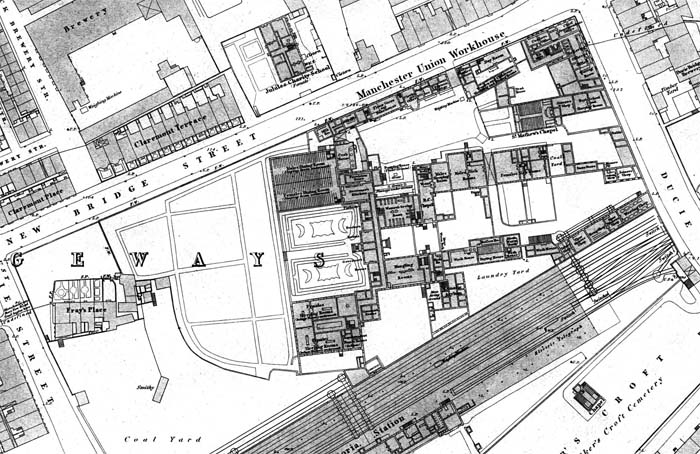|
The Manchester Union
Workhouse
 Above: the 1844 OS map - Below: My Key to the map above 
A workhouse was built
in 1792 on New Bridge Street in Manchester. It was
opened for the reception of the poor on February
14th, 1793.
Workhouses.org.uk has
an account of conditions at the New Bridge Street
Workhouse: "a
large, spacious and we may say fairly elegant
building. It was erected in 1792 upon a very
eligible piece of high ground near the influx of
the Irk and the Irwell......A manufactury of
cotton goods is carried on in the house in which
the stronger poor are employed and the children
are instructed in the arts of winding, warping and
weaving...The average number of paupers of all
ages, supported in the house, is from 350 to 400,
whose board costs per head, from three shillings
and six-pence to four shillings per week."
Frederick Engles wrote about the New Bridge Street Workhouse in his book "Condition of the Working Class in England". He said: "Below the bridge you look upon a pile of debris, the refuse, filth and offal from the courts on the steep left bank; here each house is packed close behind its neighbour and a piece of each is visible, all black, smoky, crumbling, ancient, with broken panes and window frames. The background is furnished by old barrack-like factory buildings. On the lower right bank stands a long row of houses and mills; the second house being a ruin without a roof, piled with débris; the third stands so low that the lowest floor is uninhabitable, and therefore without windows or doors. Here the background embraces the pauper burial-ground, the station of the Liverpool and Leeds railway, and, in the rear of this, the Workhouse, the "Poor-Law Bastille" of Manchester, which, like a citadel, looks threateningly down from behind its high walls and parapets on the hilltop, upon the working-people's quarter below." By 1860 the New Bridge
Street Workhouse accommodated 1,644 inmates.
In 1855 a new workhouse was erected in Crumpsall to accommodate 1,660 inmates. Workhouse.ork.uk indicates that this number was made up of: "745 able-bodied men and women; 152 women including 76 with infants; 248 idiots, imbeciles and epileptics; 255 children under 16; 60 probationers; 200 sick." The New Bridge Street Workhouse wound down gradually with some elements of it continuing to operate on this site until the First World War. As early as 1875 part of the site was sold to the Lancashire and Yorkshire Railway for an extension to Victoria Station. Then in 1881 the remaining part of the site was redeveloped with "the erection of new casual wards, relief department, female lock (venereal) wards, lying-in wards, and lunatic wards." At the outbreak of the First World War the buildings were taken over by the War Office. In the 1920s they were demolished and the land used as a railway goods yards. Today the site is occupied by the MEN Arena and the adjoining NEC car park, marked with a red dot in the photograph below.  |